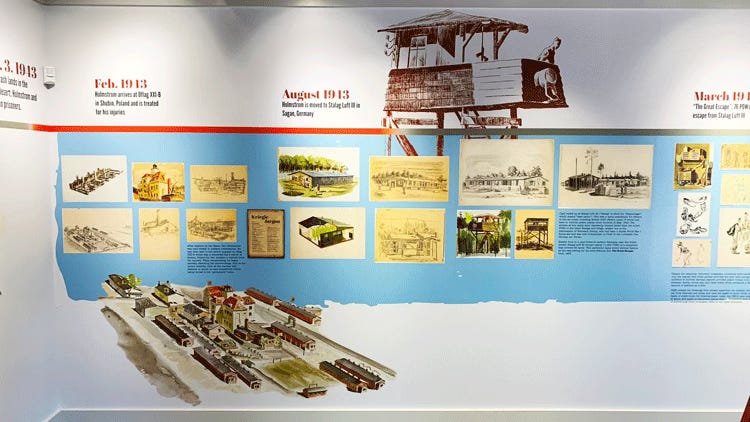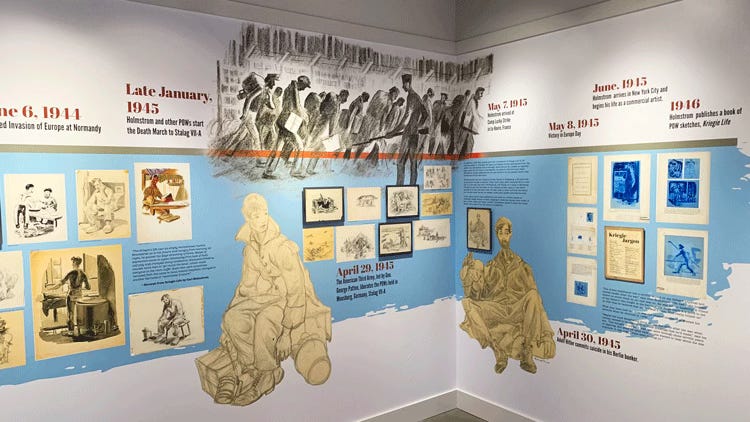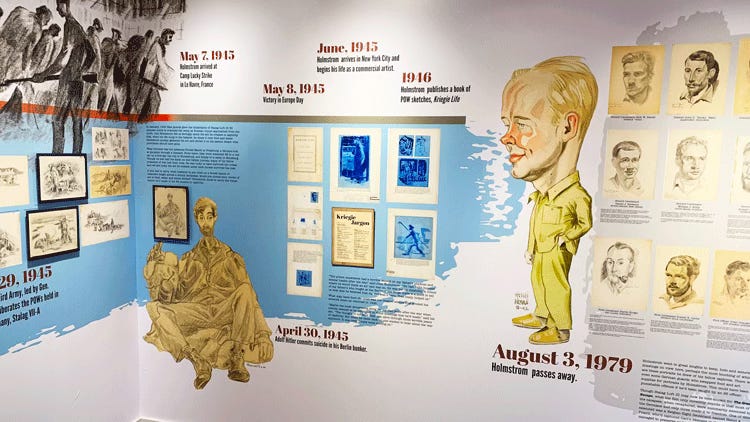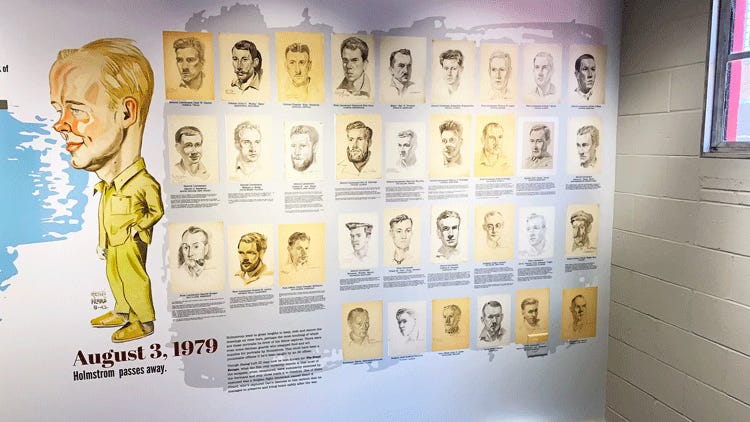Stalag Survivor: The Legacy and P.O.W. Art of Carl Holmstrom at Ball & Socket Arts
The exhibition will close on November 24, 2024
I’m still recovering from the exhibition that took place in my hometown of Cheshire, Connecticut. I’ve been involved with a lot of art exhibitions, but this had to be the most emotional event I’ve ever been in.
The highlight of the show was Grady Hearn’s short video. It features an interview with me along with a lot of archival video and information about the circumstances of his imprisonment during World War Two. Not many videos that I post to this newsletter get many views, but I think this one is different: It’s informative, interesting and very personal (especially if you know me!). His short video about the life of Carl Holmstrom describes the exhibition so well that you won’t need to see it in person. So please check it out above if you are at all interested. It’s an amazing video.

The attendance was great: Hundreds of people have already visited the show at Ball & Socket Arts in Cheshire, Connecticut since it opened on October 18. A lot of people showed up for the special Veteran’s Day event: war veterans, family members, old friends and some surprise guests.

Everyone was impressed with the quality of the presentation by Ball & Socket, as well as my father’s artwork. Doesn’t it look great?
I have to admit that after growing up and seeing my father’s illustrations all over the house and spending countless hours trying to promote it and set up exhibitions like this, viewing it now is just a part of my DNA. I absorbed all of it in my early years. I appreciate that people who see it for the first time are impressed with the quality of his artwork, and my family’s dedication to preserving it and promoting it since he passed away in 1979 (just when PUNK Magazine was going out of business and the Ramones’ “Rock ‘N’ Roll High School opened, which is a story for another day).

My father was captured in Tunisia after his first bombing mission by Nazi troops and spent the rest of the war behind barbed wire. He survived the “Death March” to Moosberg (where most of the allied P.O.W.s were held before General Patton liberated them), and carried his artwork with him in preference to food supplies.
To be honest, witnessing the effects of the PTSD that scarred him made me very anti-war, and at times anti-America. I didn’t appreciate his sacrifice to the effort to defeat Hitler at the time. I just hated seeing what combat does to people who decide to sign up and “fight.” (I especially hate hearing politicians nowadays who always say they want to “fight” for whatever when what they should be doing is finding ways to govern and make things better for the American people! Fighting should be what our troops due to foreign enemies who threaten our existence, not used against foreign countries who don’t cooperate with US corporations.)
As a result of living with my father’s PTSD I decided that I would never allow myself to get drafted to fight in Vietnam. This is an aspect of the anti-war movement of the 1960s that I think is under-appreciated. Many of us anti-war protesters in the 1960s simply did NOT want to go through what we saw happened to our fathers.
However, over the years I learned to appreciate everything he went through, and why he decided to fight in the war. Those who sign up for combat usually have altruistic reasons to defeat evil. Thankfully, although he hated me back in the day for opposing the Vietnam “conflict,” he did enough reading later on to appreciate my opposition to the military-industrial complex. We were able to make peace. And so I am now able to respect those who serve in the military: It’s a necessary evil. We really have to honor their service to our country.

A lot of very cool people showed up for the opening and Veteran’s Day events: Michael Gramaglia (Director of End of The Century: The Story of the Ramones), Brendan Toller (Director of Danny Says, the famous Danny Fields documentary), Paul Kirchner (the illustrator of High Times magazine’s “Dope Rider” comic strip and also the artist who almost illustrated the Ramones’ Road To Ruin LP cover instead of me), Ernst (a Connecticut counterculture hero) and Tom Hearn (a resident of Cheshire who took photos for Mutant Monster Beach Party as well as the best-known photos of the PUNK Magazine staff in 1976 and even worked at the printing company that published PUNK Magazine #12-#14, and #16-#17).

Tom Hearn deserves special thanks, since he had the most to do with getting this show to Ball & Socket. (He also plays in Big Fat Combo, a Connecticut rock band that performed at the PUNK Magazine 25th Anniversary show at CBGB in January 2001). He’s just one of those good people who helps make things like this happen.
Thanks, Tom Hearn!
I also want to thank Alan Bisbort, who wrote a newsletter about the event for B&S as well as a newspaper story that ran in one of Connecticut’s last remaining newspapers. We are hoping to work together on a story for the next issue of PUNK Magazine! Alan is working on a story about the Bohemian movement. I have always thought that the “Punk Movement” was another incarnation of Bohemia, like the Beatnik movement and the Hippie scene that came afterwards.
LINK to Alan Bisbort’s News Story:
Finally, thanks to Ilona Somogyi (President and Co-Founder), Lydia Blaisdell (Director of Programming) Bill Conant (Facilities Manager) and Ron Bergamo Jr. (Board Chair) at Ball & Socket, the team that put together an amazing exhibition. All of our family who attended are very thankful for their work and efforts to the show.




Thanks for the great comment! I have to say (in all modesty since all I did was talk a bit) that the video has reveived more great reviews than any video I have ever appeared in. Grady Hearn did a great job putting all of the elements together. Thanks for posting!
Thanks for posting this. Looks like a great exhibition.
I agree with you about war and PTSD. My dad was a WWII bombardier, flew a lot of missions and he got a really bad case of PTSD. It was tough growing up with a dad who had trouble controlling his temper. It wasn’t till I was an adult that I understood what he went through.